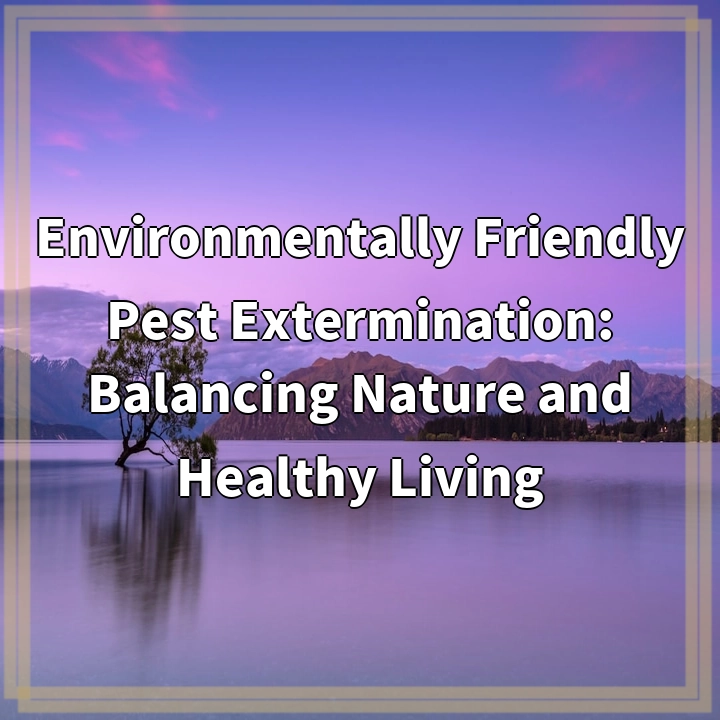
What is Environmentally Friendly Pest Extermination?
Environmentally friendly pest extermination refers to the use of methods and techniques that minimize harm to the environment and human health while effectively controlling pests. This approach focuses on finding sustainable and non-toxic alternatives to conventional chemical pesticides, to achieve a balance between pest management and preserving the natural ecosystem.
Real-World Problems Associated with Environmentally Friendly Pest Extermination
Although environmentally friendly pest extermination offers numerous benefits, there are some real-world challenges that need to be addressed:
1. Limited Effectiveness
One of the main challenges is finding methods that are as effective as conventional chemical pesticides. While some eco-friendly pest control methods can be highly effective, there are cases where they may not offer the same level of potency, especially when dealing with severe infestations.
2. Time and Patience
Environmentally friendly pest extermination methods often require more time and patience compared to conventional methods. They usually involve multiple steps and may take longer to show results. This can sometimes be a challenge, particularly for individuals or businesses that require quick and immediate solutions.
3. Limited Pest Control Options
Conventional chemical pesticides offer a wide range of options to control pests effectively. In contrast, eco-friendly pest extermination methods may have more limited options. This can pose a challenge when dealing with certain persistent pests or specific infestations that require targeted solutions.
4. Higher Costs
Environmentally friendly pest control methods can sometimes be more expensive than conventional approaches. This is due to the use of specialized tools, equipment, and organic materials. The higher costs can deter some individuals and businesses from adopting these methods, especially if they operate on a tight budget.
5. Education and Awareness
One of the challenges in implementing environmentally friendly pest extermination is the need for education and awareness. Many people may not be familiar with these alternative methods or the potential benefits they offer. It is important to spread awareness, educate communities, and debunk misconceptions surrounding eco-friendly pest control.

Solutions for Environmentally Friendly Pest Extermination
1. Integrated Pest Management (IPM)
Implementing Integrated Pest Management is a key solution. IPM focuses on evaluating the pest problem, identifying the root cause, and developing a comprehensive pest management plan. By combining various eco-friendly techniques, such as biological control, habitat modification, and cultural practices, IPM offers an effective and sustainable approach to pest control.
2. Research and Innovation
Continued research and innovation are essential in developing new and improved environmentally friendly pest control methods. Scientists and experts are exploring alternative options, such as organic pesticides derived from natural sources, pheromone-based traps, and biocontrol agents. Supporting and investing in research can lead to the discovery of more effective and eco-friendly solutions.
3. Education and Outreach
Increasing education and awareness about environmentally friendly pest extermination is crucial to drive change. Educating individuals, homeowners, businesses, and communities about the benefits, methods, and success stories of eco-friendly pest control can help overcome misconceptions and inspire adoption. Outreach programs, workshops, and informational campaigns can play a significant role in promoting sustainable pest control practices.
4. Collaboration and Partnerships
Establishing collaborations and partnerships between different stakeholders, including pest control companies, environmental organizations, and government agencies, is vital. By working together, sharing knowledge and resources, and promoting eco-friendly pest management initiatives, a collective effort can address real-world challenges and accelerate the adoption of sustainable practices.
5. Incentives and Policy Support
Providing incentives and policy support can encourage individuals and businesses to choose environmentally friendly pest control methods. Governments can offer financial incentives, tax benefits, or subsidies for eco-friendly pest control services or equipment. Developing regulations that promote sustainable pest management practices and discourage the use of harmful chemical pesticides can also drive industry-wide changes.















